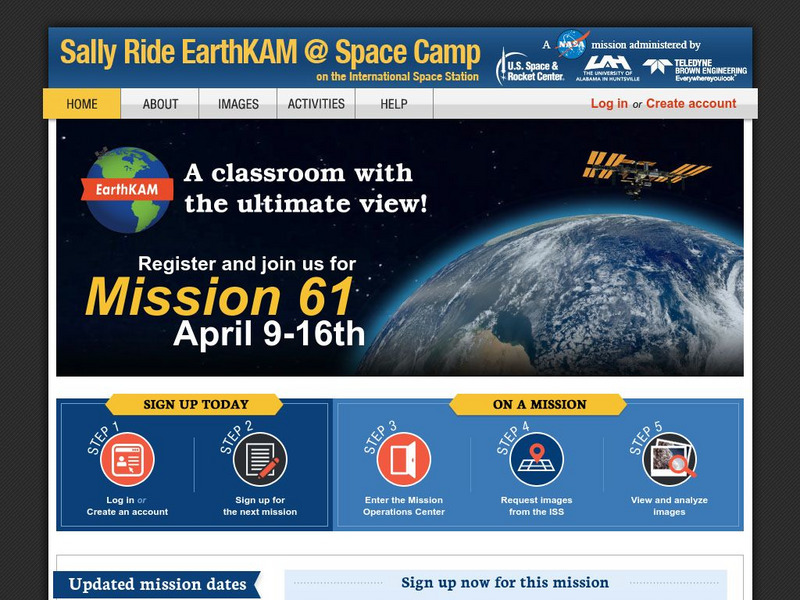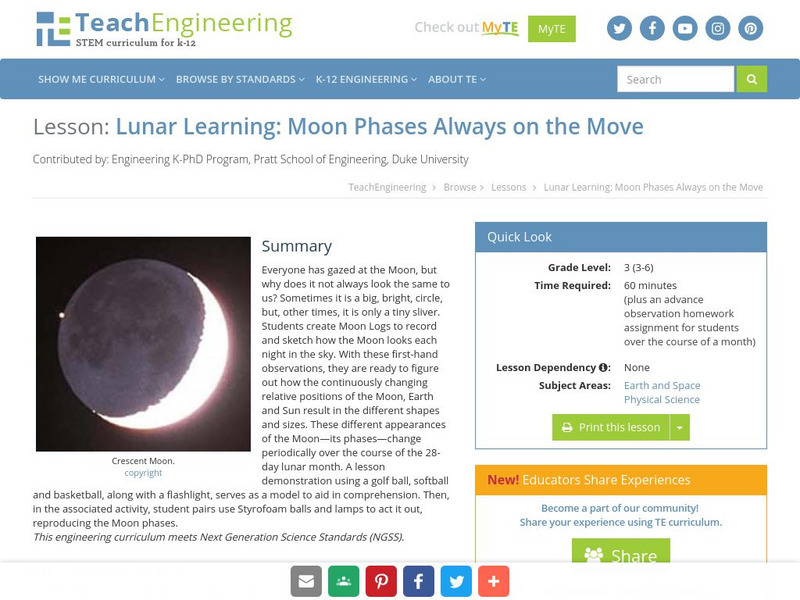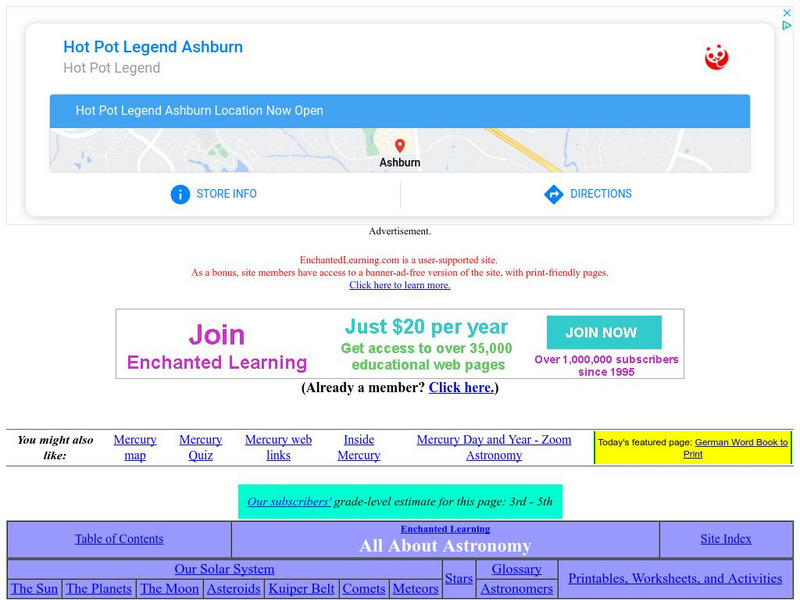Curated OER
Translation
Tenth graders identify and interpret vocabulary terms as they relate to vectors. Students practice translations by creating several tessellations. Students determine the direction and distance using vectors. Students use grid paper to...
Curated OER
Moving in Outer Space
Students participate in a lesson that demonstrates the concepts of rotation and revolution as they pertain to the Sun, the moon, and the Earth. They examine the relative sizes of each. They watch a computer based movie at a subscription...
Curated OER
Ring Around the Rosie
Students work together to discover the concept of angular momentum. They participate in experiments in which they test rotation and relate it to an object's mass. They participate in a literacy activity in which they compare mythology...
Curated OER
Exploring the Celestial Neighborhood
Ninth graders study the origin and organization of the solar system. They investigate the Earth's place in the system and how planetary motions explain natural phenomena observable from Earth.
Curated OER
Our Universe: Always Moving, Always Changing
Students explore the main concepts of astronomy through the eleven lessons of this unit. The past, present, and future methods of studying the science are examined in this unit.
Curated OER
"Use an Anemometer," said the Meteorologist
Students participate in an hands-on construction of an instrument to measure wind speed.
Curated OER
The Planet Earth
Students explore the planet Earth, outer space, and Earth's axis. They demonstrate reading comprehension skills, including literal meaning, inference and critical analysis.
Government of Alberta
Learn Alberta: Math Interactives: Exploring Transformations
This multimedia Learn Alberta math resource looks at real world examples of transformations found throughout West Edmonton Mall. The accompanying interactive component asks students to predict transformations through looking at...
University of New South Wales (Australia)
University of New South Wales: School of Physics: Physclips
Physiclips thoroughly presents mechanics concepts with animations and film clips.
University of Colorado
University of Colorado: Ph Et Interactive Simulations: Torque
Experiment how torque causes an object to rotate. This interactive simulation shows how angular acceleration, moment of inertia, angular momentum, and torque relate to one another.
Science Education Resource Center at Carleton College
Serc: Investigating Rotation: Why Is There Day and Night?
In this rotation activity, students investigate what causes day and night by participating in a classroom activity. Students will observe, question, and investigate how the relationship between the earth and sun causes day and night.
Science Education Resource Center at Carleton College
Serc: Tracking the Sun: Observing the Path of the Sun Throughout the Year
Over the course of the school year, students collect weekly data about the sun's position at a specific time of day, resulting in creating a figure "8" that shows the path of the sun called an analemma.
Math Open Reference
Math Open Reference: Plane Geometry: Transformations
Explore transformations of a polygon that include: 1) translation 2) rotation 3) reflection and 4) dilation.
Other
Nasa: Iss Earth Kam
Students get a whole new perspective of the world through images obtained from the International Space Station. Students can even request images to be taken through ISS EarthKAM. Activities and educator guides are provided.
Georgia Department of Education
Ga Virtual Learning: Ap Physics 1: Rotational Kinematics and Energy
This module is the introduction to model rotational motion. All of the concepts are conveniently recast into forms that have the same mathematical forms as their translational counterparts.
TeachEngineering
Teach Engineering: Lunar Learning
Why does the Moon not always look the same to us? Sometimes it is a big, bright, circle, but, other times, it is only a tiny sliver, if we can see it at all. The different shapes and sizes of the slivers of the Moon are referred to as...
Texas Education Agency
Texas Gateway: The Sun Is the Center of the Solar System
See what you know about the solar system by taking this brief interactive quiz and learning module.
Texas Education Agency
Texas Gateway: Making Conjectures About Congruence Transformations
Given geometric figures on the coordinate plane, the student will apply the definition of congruence, in terms of rigid transformations, to identify congruent figures. The student will also identify and distinguish between reflectional...
Varsity Tutors
Varsity Tutors: Hotmath: Practice Problems: Transformations Exercises
Twenty-five problems cover the various transformational geometry topics in different settings. They are given with each step to the solution cleverly revealed one at a time. You can work each step of the problem then click the "View...
Texas Education Agency
Texas Gateway: Comparing and Explaining Transformations
Given rotations, reflections, translations, and dilations, students will be able to develop algebraic representations for rotations and generalize and then compare and contrast the properties of congruence transformations and...
Annenberg Foundation
Annenberg Learner: Moon Journal Activity
Students use the process of journaling to make discoveries about the moon. This activity involves having students write observations about the moon in a journal. Using their observations they go to an online resource and choose...
University of Waterloo (Canada)
University of Waterloo: Cemc: Geometry and Spatial Sense: Transformations [Pdf]
Accompanied by links to online activities and demonstrations, students learn about the different types of transformations on a coordinate grid through this lesson plan. The lesson is designed to match the Grade 7 Ontario curriculum, with...
Enchanted Learning
Enchanted Learning: All About Space: Mercury
The planet Mercury is profiled with information about its size, mass, atmosphere, length of day, and the like. Features include interactive activities and learning exercises.





















